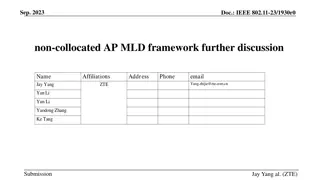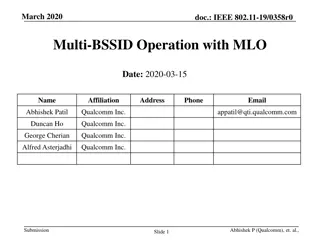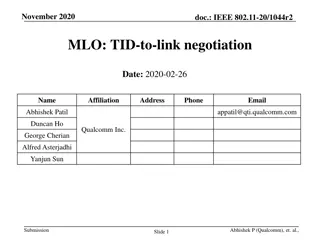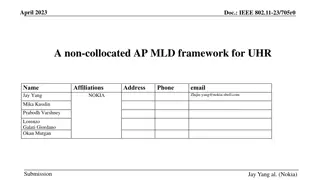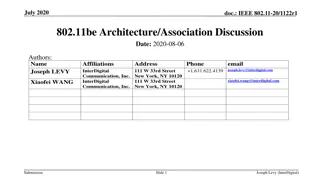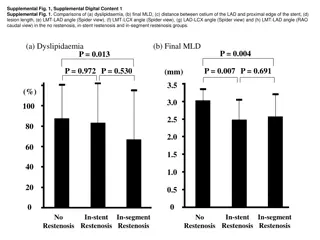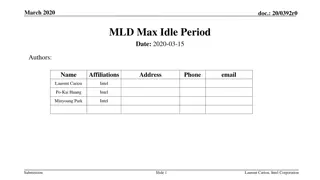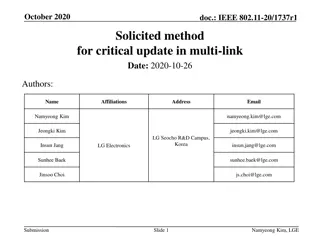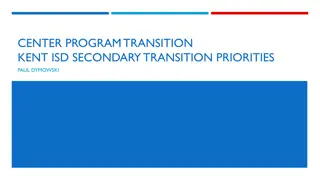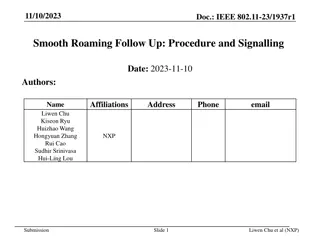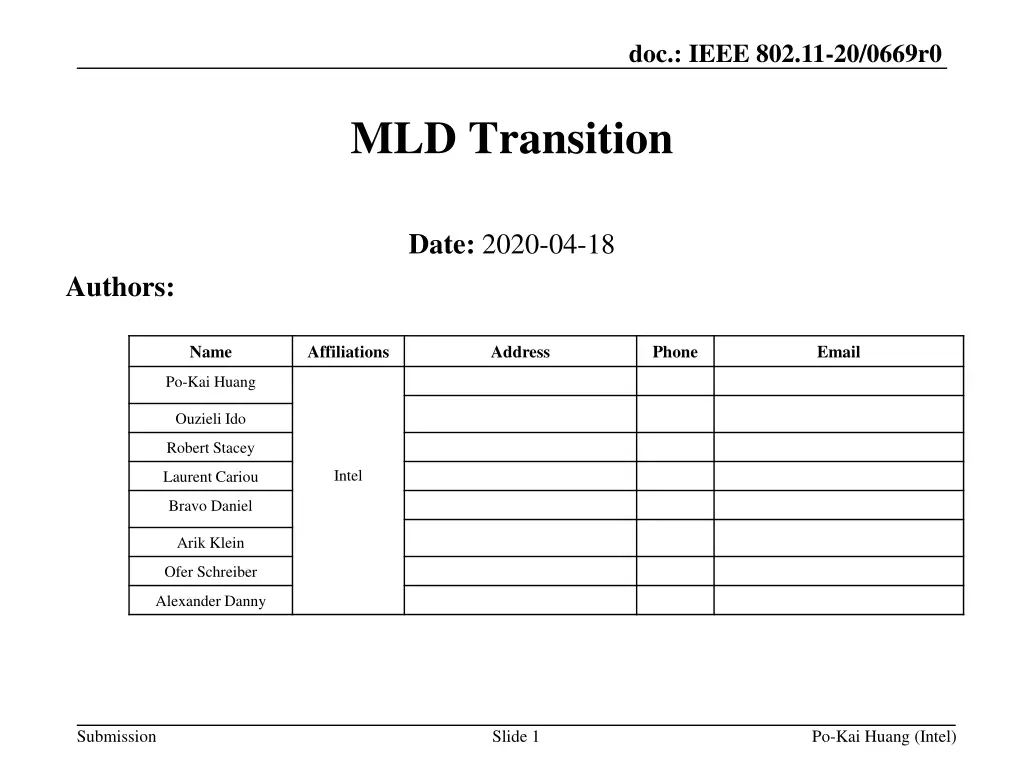
IEEE 802.11-20/0669r0 MLD Transition in ESS
Explore the IEEE 802.11-20/0669r0 document detailing MLD transition within an ESS network, including definitions, illustrations, and necessary changes between APs and legacy APs. Learn about fast MLD transitions and multi-link setup associations for enhanced connectivity.
Download Presentation

Please find below an Image/Link to download the presentation.
The content on the website is provided AS IS for your information and personal use only. It may not be sold, licensed, or shared on other websites without obtaining consent from the author. If you encounter any issues during the download, it is possible that the publisher has removed the file from their server.
You are allowed to download the files provided on this website for personal or commercial use, subject to the condition that they are used lawfully. All files are the property of their respective owners.
The content on the website is provided AS IS for your information and personal use only. It may not be sold, licensed, or shared on other websites without obtaining consent from the author.
E N D
Presentation Transcript
doc.: IEEE 802.11-20/0669r0 MLD Transition Date: 2020-04-18 Authors: Name Affiliations Address Phone Email Po-Kai Huang Ouzieli Ido Robert Stacey Intel Laurent Cariou Bravo Daniel Arik Klein Ofer Schreiber Alexander Danny Submission Slide 1 Po-Kai Huang (Intel)
doc.: IEEE 802.11-20/0669r0 Background Current spec define BSS transition as follows: BSS-transition: This type is defined as a STA movement from one BSS in one ESS to another BSS within the same ESS. Fast BSS transition: A fast BSS transition is a BSS transition that establishes the state necessary for data connectivity before the reassociation rather than after the reassociation. An ESS is the union of the infrastructure BSSs with the same SSID connected by a DS. The goal of this presentation is to expand above concept to MLD Submission Slide 2 Po-Kai Huang (Intel)
doc.: IEEE 802.11-20/0669r0 Illustration ESS AP 1 AP 2 AP 3 Multi-link (re)setup association (re)association BSS transition BSS transition Non- AP Non- AP Non- AP BSS transition Enhancement ESS AP MLD 1 AP MLD 2 MLD transition AP 1.2 AP 2.2 AP 1.1 AP 3 AP 2.1 Multi-link setup MLD transition MLD transition Non- AP Non- AP 1.2 Non- AP 1.2 Non- AP 1.1 Non- AP 1.1 Non-AP MLD 1 Non-AP MLD 1 Submission Slide 3 Po-Kai Huang (Intel)
doc.: IEEE 802.11-20/0669r0 MLD transition Define AP MLD in an ESS as follows: An AP MLD is in one ESS if the SSID of the AP MLD is the same as the SSID of the ESS. Define MLD transition as follows: A non-AP MLD movement from having multi-link setup with one AP MLD in one ESS to having multi-link setup with another AP MLD within the same ESS. A non-AP MLD movement from having multi-link setup with one AP MLD in one ESS to become a non-AP STA having association with another AP within the same ESS. A non-AP STA movement from a non-AP STA having association with one AP in one ESS to become a non-AP MLD having multi-link setup with another AP MLD with the same ESS. Define fast MLD transition as follows: A MLD transition that establishes the state necessary for data connectivity before the multi-link resetup or reassociation rather than after the multi-link resetup or reassociation. Slide 4 Submission Po-Kai Huang (Intel)
doc.: IEEE 802.11-20/0669r0 Change Required for MLD Transition Between two AP MLDs, multi-link resetup takes care of the design Between AP MLD and legacy AP, need to have non-AP MLD MAC address same as the non- AP STA MAC address connects to the BSS of the legacy AP. Essentially, we have DS mapping changes from (AP MLD 2, Non-AP MLD1) to (AP3, non-AP 1) MAC address of Non-AP MLD1 equal to MAC address of non-AP 1 provides roaming behavior with relation of two connections If MAC address of Non-AP MLD1 is not equal to MAC address of non-AP 1, then the two connections are viewed as independent connections in the current spec ESS AP MLD 2 (AP MLD 2, non-AP MLD1) Multi-link (re)setup AP 2.2 AP 3 AP 2.1 DS mapping Same MAC address (re)association (AP 3, non-AP 1) MLD transition Non- AP 1 Non-AP MLD 1 MAC address is the same as the non-AP 1 MAC address. Non- AP 1.2 Non- AP 1.1 Non-AP MLD 1 Submission Slide 5 Po-Kai Huang (Intel)
doc.: IEEE 802.11-20/0669r0 Change for fast MLD Transition We think that the current fast BSS transition signaling (FT) can be reused and expanded to fast MLD transition, we will focus on the following to illustrate the design FT initial mobility domain operation in an RSN over-the-air FT operation in an RSN Submission Slide 6 Po-Kai Huang (Intel)
doc.: IEEE 802.11-20/0669r0 First Step: Extend FT Key Hierarchy to MLD FT initial mobility domain AP MLD R1KH R0KH PMK-R0 PMK-R1 PTK FT initial mobility domain AP MLD FT initial mobility domain Non-AP MLD S1KH S0KH Target AP MLD R1KH Target AP MLD PTK S1KH Non-AP MLD Submission Slide 7 Po-Kai Huang (Intel)
doc.: IEEE 802.11-20/0669r0 Proposed Spec Change For a non-AP MLD and an AP MLD in a FT initial mobility domain operation, use non-AP MLD address as S1KH-ID and S0KH-ID and AP MLD address as R1KH-ID. For a non-AP MLD and a target AP MLD in an over- the-air FT operation, use non-AP MLD address as S1KH-ID and AP MLD address as R1KH-ID. Submission Slide 8 Po-Kai Huang (Intel)
doc.: IEEE 802.11-20/0669r0 Second Step: Change for FT initial mobility domain Setup in an RSN Sequence Need non-AP MLD address and AP MLD address to calculate PMKID, PTK, PTKName MLD address can be exchanged in Authentication request/response and association request/response Delivery GTK, IGTK, BIGTK in different links in FT 4-way handshake AP MLD Non-AP MLD Multi-link Element Multi-link Element R0KH: PMK-R0 PMK-R0 Name PMK-R1 S0KH R1KH: PMK-R1 PTK S1KH Need to provide GTK/IGTK/BIGTK of different links here. Submission Slide 9 Po-Kai Huang (Intel)
doc.: IEEE 802.11-20/0669r0 Computation of PMK-R0, PMK-R0Name, and PMK-R1 Non-AP MLD address Non-AP MLD address AP MLD address Submission Slide 10 Po-Kai Huang (Intel)
doc.: IEEE 802.11-20/0669r0 Computation of PMKR1Name, PMKID, PTK, PTKName Non-AP MLD address AP MLD address AP MLD address Non-AP MLD address AP MLD address Non-AP MLD address Submission Slide 11 Po-Kai Huang (Intel)
doc.: IEEE 802.11-20/0669r0 Third Step: Change for over-the-air FT protocol authentication in an RSN Need non-AP MLD address and AP MLD address to calculate PMKID, PTK, PTKName MLD address can be exchanged in Authentication request/response and association request/response Deliver GTK/IGTK/BIGTK in FTE Current AP MLD Target AP MLD R1KH: PMKR1Name ------------------- PTK PTKName Multi-link Element (short) PTK PTKName Need to provide GTK/IGTK/BIGTK of different links here. Multi-link Element Submission Po-Kai Huang (Intel) Slide 12
doc.: IEEE 802.11-20/0669r0 FTE Have multiple multi-link GTK/IGTK/BIGTK subelement Submission Slide 13 Po-Kai Huang (Intel)
doc.: IEEE 802.11-20/0669r0 Extension to other procedures Following similar design philosophy, we can extend MLD transition to the following: Over-the-DS FT protocol Clarify STA Address field in FT action frame is the MLD address if roaming to an AP MLD Clarify Target AP address field in FT action frame is the AP MLD address if roaming to an AP MLD FILS authentication Clarify this is done between two MLDs Deliver GTK/IGTK/BIGTK of different links in a Key Delivery element of (Re)Association response frame. Submission Slide 14 Po-Kai Huang (Intel)
doc.: IEEE 802.11-20/0669r0 Conclusion We discuss how to expand BSS transition concept to MLD transition in this presentation We demonstrate that by considering the transition in MLD level and use MLD MAC address, all the existing FT signaling can be reused with the additional multi- link information For MLD transition involves a legacy AP and a AP MLD, the non-AP MLD that has multi-link (re)setup with the AP MLD has non-AP MLD MAC address equal to MAC address of the non-AP STA that has (re)association with the legacy AP Submission Slide 15 Po-Kai Huang (Intel)
doc.: IEEE 802.11-20/0669r0 Straw Poll Do you support the following definition: Define AP MLD in an ESS as follows: An AP MLD is in one ESS if the SSID of the AP MLD is the same as the SSID of the ESS. Define MLD transition as follows: A non-AP MLD movement from having multi-link setup with one AP MLD in one ESS to having multi-link resetup with another AP MLD within the same ESS. A non-AP MLD movement from having multi-link setup with one AP MLD in one ESS to become a non-AP STA having reassociation with another AP within the same ESS. A non-AP STA movement from a non-AP STA having association with one AP in one ESS to become a non-AP MLD having multi-link resetup with another AP MLD with the same ESS. Define fast MLD transition as follows: A MLD transition that establishes the state necessary for data connectivity before the multi-link resetup or reassociation rather than after the multi-link resetup or reassociation. Submission Slide 16 Po-Kai Huang (Intel)
doc.: IEEE 802.11-20/0669r0 Straw Poll Do you support to reuse existing frame exchange of FT for fast MLD transition? Submission Slide 17 Po-Kai Huang (Intel)
doc.: IEEE 802.11-20/0669r0 Straw Poll Do you support the following? For a non-AP MLD and an AP MLD in a FT initial mobility domain operation, use non-AP MLD address as S1KH-ID and S0KH-ID and AP MLD address as R1KH-ID. Use AP MLD address and non-AP MLD address to compute PMKID, PTK, and PTKName For a non-AP MLD and a target AP MLD in an over-the-air FT operation, use non-AP MLD address as S1KH-ID and AP MLD address as R1KH-ID. Use AP MLD address and non-AP MLD address to compute PMKID, PTK, and PTKName Submission Slide 18 Po-Kai Huang (Intel)
doc.: IEEE 802.11-20/0669r0 Straw Poll Do you support the following? For a non-AP MLD and an AP MLD in a FT initial mobility domain operation, deliver GTK/IGTK/BIGTK in different links in one FT 4-way handshake For a non-AP MLD and a target AP MLD in an over-the-air FT operation, deliver GTK/IGTK/BIGTK in different links in FTE of reassociation response of the over-the-air FT protocol Submission Slide 19 Po-Kai Huang (Intel)
doc.: IEEE 802.11-20/0669r0 Straw Poll Do you support that for an MLD transition between a legacy AP and an AP MLD, the non-AP MLD MAC address used by the non-AP MLD for multi-link (re)setup with the AP MLD shall be equal to the MAC address of the non-AP STA used for (re)association with the legacy AP? Note: a transition with tear down of previous association/setup, and new association/setup is not an MLD transition Submission Slide 20 Po-Kai Huang (Intel)

